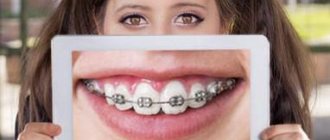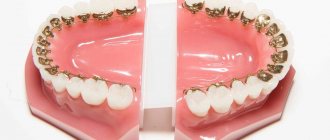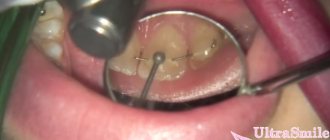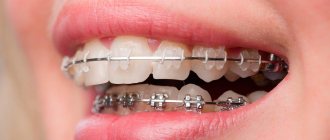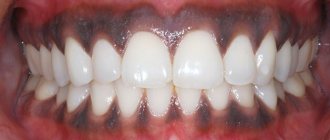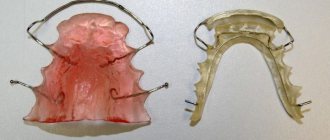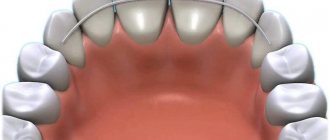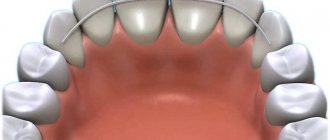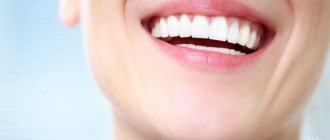Publication date: December 26, 2022.
Date the information on this page was updated: February 02, 2022.
Before installing braces, it is difficult to imagine the sensations in your mouth after installing an unusual structure made of ceramic or metal. Some people even put off orthodontic treatment due to fear of pain. In this article we will try to explain what sensations arise when installing, wearing and removing braces, why they occur and how to reduce discomfort.
Why does pain occur when wearing braces?
To begin with, let's figure out how the dental system works and how braces work. Teeth grow from the alveolar process, a bone formation in the jaw. The roots of the teeth are fixed in the bone tissue by a ligamentous apparatus - periodontium.
Due to the traction of the arc, braces move not only the part of the teeth that is visible to us - the crown, but also the roots of the teeth. Under the influence of braces, the ligaments, which contain many nerve endings, gradually stretch and the tooth moves along the bone tissue.
It is the processes of movement of the roots of teeth that cause sensations of varying degrees of intensity in people, depending on the individual pain threshold. Some people feel quite severe pain, some only have unpleasant feelings when biting food, others experience itching and mobility of teeth.
What does it feel like while wearing braces?
- Aching pain, especially aggravated when biting food and chewing.
- Chafing of cheeks, lips and tongue from clasps, orthodontic hooks and wires. During the first time after installation, the mucous membrane gets used to the structure in the mouth, the tongue and lips tend to take their usual position, but encounter braces. Sometimes it is impossible to close your lips or articulate clearly. Over time, the mouth and lips adapt to braces and the pain goes away. Getting used to with lingual braces takes longer than with classic braces, since they are located on the inside of the teeth and greatly interfere with the tongue.
- Feeling of tooth mobility and “soft” teeth. It seems that the tooth is loose or, when biting and pressing, “sinks” into the gum. In fact, the teeth are mobile, but not so much that they fall out or suddenly change position.
- Itching in the teeth and gums. Some patients' teeth do not hurt, but itch and itch. This, like aching pain, is the result of irritation of nerve endings during the gradual restructuring of periodontal and bone tissue. If you experience such sensations, you should never try to mechanically scratch your gums (with a toothpick, hard brush, etc.) - you can seriously injure yourself.
When does discomfort or pain occur during orthodontic treatment?
When wearing braces, your teeth do not constantly hurt: soon after installation, the oral cavity adapts to the structure, and the braces act on the ligaments gradually and gently. The sensations from braces are especially strong during the installation and activation stages, when the teeth are not yet accustomed to the pressure and new position.
Feeling when installing braces
The process of installing braces consists of three stages: preparing the teeth, gluing with a lock and installing the arch. The first 3 stages are absolutely painless - with healthy enamel (and this is a prerequisite for installing braces), applying the adhesive, drying and etching the tooth does not cause any discomfort. But when fixing the arch, a feeling of tightness and “heaviness” of the teeth appears. It is from this moment that braces begin to work - the arch, fixed in the grooves of braces on uneven teeth, strives to take its original “correct” position and pulls the teeth along with it.
In the first 1-3 weeks, unusual pressure is placed on the teeth, and the patient may experience quite severe pain. During this period, it is difficult to chew even soft foods, because with any pressure on the teeth, the pain worsens significantly, and a feeling of mobility appears.
During this period, in addition to pain in the area of the roots of the teeth and the alveolar process, the cheeks, lips and tongue may hurt due to unusual contact with braces.
Feelings when wearing braces
After adaptation to braces, severe pain goes away, and the design becomes familiar - most of the time, patients do not notice the presence of braces and live a normal life.
Discomfort returns with periodic activation of braces - on average once every 3 months. At appointments, the orthodontist can replace the archwire with a more rigid one, make bends in the archwire, re-glue the clasps, install a chain, or fix hooks for elastics.
Elastic traction for braces
After each small change, braces begin to work in a new way - pulling the teeth a little harder, or at a slightly different angle. The teeth begin to realign again and the patient may experience pain or discomfort. New hooks for elastics can injure the mucous membrane at first.
If the orthodontist has prescribed the wearing of rubber bands - elastics, then they can become a source of unusual sensations in the mouth: they pull and put pressure on individual teeth. Sometimes the sensation spreads to the entire jaw: it feels heavy and tense.
Feelings when removing braces
Even if after two years of wearing braces it seems that the braces have become one with the teeth and it will be painful to remove them, do not be afraid. In fact, removing braces is safe and painless due to the removal technology and special tools.
The bracket is grabbed with special pliers, which are securely fixed on the sides of the lock and do not slip off. The orthodontist squeezes the forceps, under pressure the bracket is slightly deformed, and its base easily peels off from the tooth. Next, the teeth are cleaned of the adhesive and polished.
Removing braces
The entire removal process takes up to 30 minutes and does not injure the teeth, gums or mucous membranes. Sometimes you can only feel a slight pressure when peeling off the locks.
Types of braces systems and their installation
Depending on the degree of complexity of correcting existing defects and the planned time for the patient to wear braces, the doctor suggests two main types of their design:
- Removable bracket system
It is recommended to remove it before eating and while brushing your teeth.
- Fixed system
The system is not removed for the entire duration of treatment. While wearing it, the doctor regularly makes certain adjustments.
None of the patients complained that their teeth hurt from braces when they were installed. Although such a procedure can last 1.5-2.0 hours. The painlessness of the operation is explained by the fact that the design of the braces during installation comes into direct contact with the tooth enamel, which has no nerve endings and simply does not feel pain.
The above installation times are averages. The duration of the operation depends on the following:
- doctor's qualifications and practical experience.
- individual characteristics of the patient’s teeth and jaw.
Pain when wearing braces that is not normal
Above we described discomfort with braces, which is normal. But some painful sensations indicate inflammatory or pathological processes.
The fact is that orthodontic treatment is a serious test for the body. The entire dental system is being rebuilt and requires special monitoring and care.
What sensations may indicate the presence of dental diseases:
- Aching and sharp pain in individual teeth
can be caused by caries or inflammation of the canals. - Pain in the area of contact between the gums and teeth
as a result of recession - loss of gums. Recession often accompanies orthodontic treatment, as the roots of the teeth move and put pressure on the periodontal tissue, which can cause gradual gum resorption. - Pain in the temporomandibular joint.
Some patients are predisposed to TMJ dysfunction - the joint can move into a new position during orthodontic treatment and cause discomfort and discomfort. You must report them to the orthodontist - the doctor will take the necessary measures. - Enamel sensitivity
. Braces make hygiene difficult and can weaken tooth enamel. If the enamel is excessively sensitive, you should definitely visit a therapist or hygienist. A specialist will clean and remineralize your teeth.
To prevent the development of inflammation, undergo professional hygiene and a preventive examination with a therapist at least once every six months. Report any strange or sharp sensations in your teeth, gums and joints to your orthodontist.
Why do braces chafe?
The orthodontic system has a certain volume. It consists of streamlined clasps that can come off, a power arc that protrudes significantly forward in relation to the front surface of the teeth. Ligature systems additionally have ligatures, thin wires that secure the arch to the braces.
Normally, the amount of space between the teeth and the soft tissues of the face (the inner surface of the cheeks and lips) is very small. It is supported by a certain tone of the facial and chewing muscles. In order for the muscle tone to change taking into account the installed structure, time must pass. Usually this is 2 weeks or more.
Immediately after installation, the system is perceived as a foreign object in the mouth, which interferes with chewing, speaking, “rests” with all protruding parts on the mucous membrane, and rubs against the tissue during muscle contraction. To a certain extent, this discomfort is acceptable and is one of the disadvantages of correcting the position of teeth with braces.
For example, slight bleeding of the mucous membranes at the points of contact of structural elements with tissues is not a reason to consult a doctor if this is a one-time bleeding and the mucous membrane heals within a short time. The soft tissues of the oral cavity are well supplied with blood. This is facilitated by a dense capillary network, which produces profuse bleeding in response to any minor damage.
It’s another matter if erosions and ulcers form, which can become an “entry gate” for infection. The enzyme lysozyme contained in saliva usually suppresses the proliferation of microorganisms. However, its effect may be insufficient in the case of long-existing defects.
How to relieve pain when wearing braces?
Each patient experiences individual sensations from braces, but even severe pain can be reduced if you follow the recommendations of doctors.
At the stage of choosing braces:
- Choose self-ligating braces - they put less aggressive pressure on the teeth than ligature ones. In self-ligating braces, the arch slides freely in the groove, and the force is distributed evenly.
- If you need faster and easier adaptation to braces, choose external or vestibular braces - they do not injure the tongue and do not spoil diction.
After installation and activation:
- Use orthodontic wax to smooth out protruding elements that rub the mucous membrane.
- Doesn't eat solid food. In the first 3 weeks after installing braces, it is recommended to eat only soft or pureed foods: purees, soups, etc.
- Rinse your mouth with anti-inflammatory agents (saline solution, chamomile decoction) so that inflammation does not occur at the site of the wounds from braces.
- Use healing gels to treat mucous membranes.
- Eat ice cream or drink cool water - cold foods reduce sensitivity.
Sensitivity while wearing braces varies from person to person. It is possible that orthodontic treatment will be completely free of pain and discomfort. But even painful sensations are not constant and are easily neutralized. And the excellent result after braces compensates for all the inconveniences.
Is it possible to fix braces that cause discomfort?
For the patient, fears are completely natural. However, there is no doubt about whether it is possible to fix braces that cause discomfort. During the examination, the doctor will assess the situation from a technical point of view, examine the braces and check the correct installation, the length of the arch and the position of the locks.
If everything is in order, the dentist will prescribe a rinse with an anesthetic. At first, this will help relieve pain, and then the discomfort will disappear naturally. There is also a special orthodontic wax to protect the oral cavity. Wax is applied to the braces in those places that rub the mucous membrane. It is easy to use on your own, at home. Before eating, the wax must be removed from the braces.
What are braces?
Braces are one of the most advanced and progressive methods of orthodontic treatment.
Its advantages include the ability to correct complex dental anomalies and control tooth movement. Thanks to this, braces remain the leading direction for correcting malocclusion and other disorders [1]. The bracket system is a complex structure. Traditionally it includes:
- An archwire is a thin and flexible metal cord that passes through the clasps on all the teeth covered by the braces system. The arch is made of a special metal that has memory and can take a given position, gradually “pulling” the teeth along with it and thereby aligning their position in the oral cavity. The thicker the arc, the stronger its effect.
- Braces are special clasps made of metal, polymer or ceramic. They are glued to the surface of each tooth that is to be affected by the device. An arch passes through all the braces, thus transferring force to the teeth.
- A ligature is an element of a lock that fixes the arch, preventing it from moving.
Currently, both ligature and non-ligature or self-ligating systems are used. In the latter, the fixing elements are built into the locks.
The disadvantages of braces include increased hygiene requirements, the need for frequent adjustments by a specialist, some discomfort during installation and wearing, as well as aesthetic defects.
Duration of treatment with braces in children
Correcting a bite in childhood is much easier, since the bone structures have not yet fully formed and can be easily corrected. The sooner treatment begins, the less time it will take to make your smile perfect. If before braces the child wore other orthodontic structures (plate, trainer), then the treatment time can be reduced by almost half. On average, the treatment period for children is 8 months less than for adults. Therefore, the answer to the question “at what age is it best to install braces” will be 12 – 14 years.
Pain Relief Methods
There are several ways to get rid of pain after removing orthodontic appliances.
- Correction of diet. The menu includes foods rich in calcium, phosphorus and fluorine. It is worth eating fish, legumes, dairy products, fresh vegetables and herbs more often.
- Remineralization of enamel. It is carried out in the clinic and includes several stages - removal of plaque, drying, treatment with restorative preparations, and coating with fluoride varnish.
- Deep fluoridation. It is carried out 1-2 times a year and is based on sealing the enamel with a fluoride-containing solution.
The dentist selects a suitable method for restoring tooth enamel individually.
